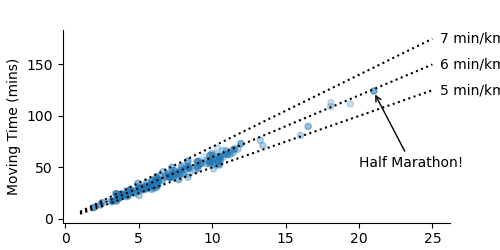I recently ran my first half marathon! I’m also signed up for a full marathon in October. 😬
Anyway, to celebrate the occasion and because I have now have a reason to think about how fast I might run a particular distance. I had a look at my historical run data. There’s a great website called statshunter that you can authorise to Strava and from which you can download a little csv of all your runs. The first logical thing I could think to do is to see how fast I tend to run different distances.
A friend lent me a huge running book which I’m going to dig through more but I suspect one of the conclusions will be a bit obvious: I could run those shorter distances a lot faster.
That same friend also lent me a heart rate watch which I’ve been playing with. So the next thing I want to learn about is what type of heart rates you should target when you train for a particular event.
Code:
from matplotlib import pyplot as plt
import numpy as np
from datetime import datetime
import pandas as pd
runs = pd.read_csv("runs.csv", parse_dates = ["Date"]) # Get this from statshunter.com
f, (ax2, ax) = plt.subplots(nrows=2, figsize = (5,5), sharex = True,
gridspec_kw = dict(height_ratios = (1,2)))
ax.set(ylabel = "Moving Time (mins)", xlabel = "Distance (km)")
x = runs["Distance (m)"].values/1e3
y = runs["Moving time"].values/60
dists = np.linspace(1, 25, 2)
for i in [5,6,7]:
mins_per_km = i * dists
ax.plot(dists, mins_per_km, color = "black", linestyle = "dotted", label = f"{i} min/km")
ax.text(25.5, 25*i, f"{i} min/km", va = "center")
ax.annotate("Half Marathon!", (x[0], y[0]-1), (20, 50), arrowprops = dict(arrowstyle = "->"))
ax.scatter(x, y, s=20, alpha = 0.6*fade_out_by_date(runs["Date"]))
for a in [ax, ax2]: a.spines[['right', 'top']].set_visible(False)
ax2.hist(x, bins = 30, alpha = 0.5)
ax2.set(yticks=[], ylabel = "Frequency Density")
f.savefig("time_vs_distance_plus_hist.svg", transparent=True)
